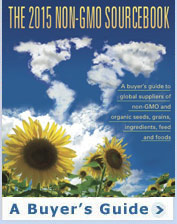Seralini study threatens scientific paradigm that GMOs are safe
Published: November 1, 2012
Category: GMO Food Health Risks

To access all the articles in this month's issue of The Organic & Non-GMO Report, SUBSCRIBE NOW.
Author of GM corn study on rats subject to smear campaign by pro-GMO scientists, media
It’s a familiar scenario: A scientist publishes a study detailing negative health or environmental impacts of genetically modified organisms. Pro-GMO scientists then attack the research as shoddy and even try to smear the reputation of the scientist.
This happened to Arpad Pusztai, who was fired and muzzled after telling a British television audience that he wouldn’t eat GM potatoes because they harmed rats. It happened to Ignacio Chapela who, was the target of a smear campaign by a Monsanto PR firm after publishing research detailing GMO contamination of native corn in Mexico. It happened to Emma Rosi-Marshall, who was attacked after publishing a paper that found GM corn to be harmful to aquatic insects. And there are others.
“Surprised by violent reactions”
But those attacks pale in comparison to the vitriol being directed at Gilles-Eric Seralini who heads the Institute of Biology at the University of Caen in France. In September, Seralini ignited a firestorm when he published results of a two-year study showing that rats fed Monsanto’s GM corn and glyphosate herbicide suffered premature deaths, tumors, and internal organ damage.
Shortly after the study became public, pro-GMO scientists and media outlets, primarily in the United States, launched a smear campaign. “Corny Scare Tactics” said a headline in the Chicago Tribune. “Scientists Smell a Rat in Fraudulent Genetic Engineering Study” said Forbes magazine.
Seralini, whose study was published in the peer-reviewed journal Food and Chemical Toxicology, was taken aback by the fury, telling Down to Earth: “We are surprised by the violent and rapid reactions by scientists within 24 hours. Was it because of their financial interests? Or were they involved in the insufficient assessment of agricultural GMOs on health?”
He also pointed out that the first reactions came from scientists who have not published any peer-reviewed scientific papers on mammalian or human toxicological studies. This was the case with Maurice Moloney, chief executive of the UK Rothamsted Research, one the first scientists to attack the paper, who had earlier worked with Calgene where he developed the world’s first GM oilseed crops.
“Latest in a series of orchestrated campaigns of harassment”
But many independent scientists have rallied to Seralini’s defense. ENSSER (European Network of Scientists for Social and Environmental Responsibility) issued a statement saying, “The vitriolic attacks evoked by the study reveal the lack of appropriate methodologies for long-term studies to assess the effects of life-time consumption of GM foods.” In addition, several hundred scientists from around the world signed on to an open letter supporting Seralini, denouncing the attacks on him and other independent researchers involved in GMO risk assessment. The letter stated: “Seralini and colleagues are just the latest in a series of researchers whose findings have triggered orchestrated campaigns of harassment.”
This attack on Seralini, as well as earlier attacks on other independent scientists who have published studies raising concerns about health and environmental risks of GMOs, are a threat to the scientific paradigm subscribed to by many scientists, biotechnology companies, and even the media that genetic engineering food is a safe, beneficial technology. The vehemence of their attacks on research that indicates otherwise demonstrates their anger and fear that this paradigm—or ideological belief—is false and that, on the contrary, GMOs threaten human health and the environment. More independent research such as that conducted by Professor Seralini should be encouraged and conducted to determine the truth.
© Copyright The Organic & Non-GMO Report, November 2012




